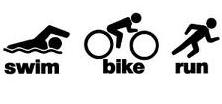1 mile = 1.60 kilometers
No problem. Enter your distances in kilometers, divide by 1.6 to convert to miles, and use the system as currently designed. For example:
You could do the same for swimming, converting meters to yards, but I personally wouldn’t bother. I would simply round off and say that 1 meter ≅ 1 yard. Neglecting the difference between meters and yards gives you are an error rate of slightly less than 9%, which is wholly acceptable in a system that already neglects aerobic intensity in its entirety.
Aerobic intensity is not a consideration that should be neglected, but it is outside the scope of this particular project. The points system merely tracks bulk training accumulations in the way that one might track mileage when training for a marathon. Of course it matters whether you ran fast or slow, did interval work, or worked at recovery pace, but at the end of the week, you probably just wrote down “40 miles” and then made some notes about the task and purpose of each of your runs. That’s certainly what I do. With that in mind, building anything more than a very rough equivalence with which to track training is not only unnecessary, it’s actively pointless.
To be clear: I’m not trying to give you a training plan here. Coaches are great, and especially for inexperienced athletes, having someone else help you develop your plan is extremely helpful. Even if you have a coach, though, you will still want a way to track your progress over time. Makes sense?
So. We can adapt the system as is directly to the metric system using a spreadsheet, but that’s not necessarily the right solution. After all, one of the nice things about the Imperial version of the system is that the calculations involved are intuitively obvious.
1 point = 100 yards swimming = 1 mile cycling = 1/4 mile running
It doesn’t take rocket science to figure out how many points you did right after a workout. But if we start dividing 2/3 of our work by 1.6, now we’re introducing an element of math into the system that makes the whole system a lot more cumbersome. A better solution would therefore be a more obvious solution.
To develop this solution, I started with the basic idea that:
1 mile cycling = 1/4 mile running
Therefore…
1.6 km cycling ≅ 1.5 km cycling
That’s a little cleaner. Granted, it changes the equivalence by a little more than 6.7%, but as we already discussed, this is negligible in a system that already neglects aerobic intensity. It gives you a little more credit for each kilometer you ride, but that’s not necessarily a problem.
Similarly...
.4 km running ≅ .5 km running = .31 miles running
That’s a bigger change, and it’s one that gives you less credit for running, rather than more. In fact, it’s enough of a change that you might actually want to go the other way with it and say…
.4 km running ≅ 1/3 km running = .21 miles running
This one has the advantage of rounding in the same direction as the change to the cycling formula, and speaking personally, it’s probably a little more accurate for a guy like me—for whom swimming and riding are relatively easy while running is relatively difficult. Writing it this way gives you slightly less than 5 points per mile running rather than 4, which is probably a better equavalence for me personally.
All of which gives us two potential formulas. One is appropriate for runners and one is appropriate for swimmers.
For runners:
100 meters swimming ≅ 1.5 km cycling ≅ 1/2 km running
This is the same as saying…
110 yards swimming ≅ .94 miles cycling ≅ .31 miles running
This is not very different than what we got from the initial formula. You have to swim a little further and run a little further to equal a mile’s worth of riding, but I can live with that if I have to.
For swimmers:
100 meters swimming ≅ 1.5 km cycling ≅ 1/3 km running
This is the same as saying…
110 yards swimming ≅ .94 miles cycling ≅ .21 miles running
Again, this is not very different from the original formula. You have to swim slightly further to get a point, and like I said, that’s a good change if you’re good at swimming. If I was using this formula to track my own training in meters, I would certainly use this second version and give myself slightly more credit for running and riding and slightly less for swimming.
Bottom line: you have to adapt this stuff to suit your own needs. Any of these equivalences is going to be rough. You need to decide which is more accurate for you personally and then you use this system as you see fit.
Bottom line: you have to adapt this stuff to suit your own needs. Any of these equivalences is going to be rough. You need to decide which is more accurate for you personally and then you use this system as you see fit.



Awesome. Not only all the mathematical analysis you did, but also the clarification on aerobic intensity and relative values of workouts beyond the mileage - I mean, kilometrage.
ReplyDeleteHa!
DeleteThanks. I actually think the metric version of the formula works a little better than the standard version, but I doubt I'll make a switch.